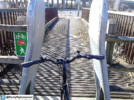The thing is my bike is motorised, and I want best of both, I want a bike which is allowed on cycle tracks, so power output and speed is limited, we have 5 speeds it seems, 4 MPH allowed on the walkways, 8 MPH can have 4 wheels and used without a licence, 16 MPH can have 2 wheels and used without a licence, 28 MPH needs a licence but classed as a quad, so many items do not need to comply in the same way as vehicles over 28 MPH, seems the Citroen Ami falls into this category.
You need to be class as disabled for some vehicles, but a bike is allowed to travel at 4 MPH without peddling. Normally called walk assist. Not sure about three wheeled vehicles, but the quad can get away without the crash protection, so can be much lighter, as can a motorcycle, I assume this includes three wheel vehicles, but many old vehicles can't be permitted on British roads if they we ever scrapped, even if rescued and brought back to new condition.
The
Scammell Scarab for example, a few were refurbished after being officially scrapped, but can only be transported to shows, they are not allowed on the road. No brakes on front wheel means can't be re-registered.
Visit
The national waterways museum in Ellesmere Port and they have tow path tugs to put the narrow boats before narrow boats had motors built in, but most tow paths today would not permit their use.
I have seen Saturn one of the few horse drawn narrow boats have problems with anti motorbike barriers, which also stop horses. And many push bikes and their trailers.
For a push bike 24 kg is heavy, mainly due to having a motor and battery, wife's not quite so heavy as does not fold, but still 22 kg, putting them on their rear wheel to get through a kissing gate

is not really an option, and lifting it high enough to pass through these

is not really an option. It seems local authorities don't mind cycle tracks, as long as no one but a select few can used them, even pedestrians have problems

they can size and crush motorcycles using cycle paths, which must surely deter people using them on cycle tracks, in Rhyl the barriers have a gate with a radar lock on them for wheel chairs, however only way my mother could unlock it was to give me the key, she could not unlock it without leaving the wheel chair, and as an amputee that was not an option.




